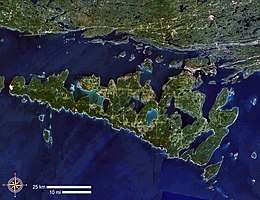Manitou
Manitou (/ˈmænɪtuː/), akin to the Iroquois orenda, is the spiritual and fundamental life force among Algonquian groups in the Native American theology. It is omnipresent and manifests everywhere: organisms, the environment, events, etc.[1] Aashaa monetoo means "good spirit", while otshee monetoo means "bad spirit". When the world was created, the Great Spirit, Aasha Monetoo, gave the land to the indigenous peoples, the Shawnee in particular.[2]

Overview
The term manitou was already in widespread use at the time of early European contact. In 1585, when Thomas Harriot recorded the first glossary of an Algonquian language, Roanoke (Pamlico), he included the word mantóac, meaning "gods" (plural). Similar terms are found in nearly all of the Algonquian languages.
In some Algonquian traditions, Gitche Manitou refers to a "great spirit" or supreme being. The term has analogues dating to before European contact, and the word uses of gitche and manitou themselves existed prior to contact. After contact, however, Gitche Manitou was adopted by some Anishinaabe Christian groups, such as the Ojibwe, to refer to the monotheistic God of Abrahamic tradition, often due to missionary syncretism.
Algonquian religion acknowledges medicine men, who used manitou to see the future, change the weather, and heal illness.[3] Ojibwe medicine men were primarily healers who used their spiritual connection to cure patients, since illness was the believed to be caused by magic and spirits.[4] To communicate with spirits and manipulate manitou, a healer would enter a trance, induced by singing, dancing, drum beats, or the use of hallucinogens. Non-healers could also interact with spirits by embarking upon a "vision quest," by means of prayer, fasting, hallucinogens, and/or removing themselves from the society of others. A person who underwent vision quests would be visited by an "animal, voice, or object," which would become his (or her) guardian spirit.[5]
In shamanistic tradition, manitous (or manidoog, or manidoowag) are connected to achieve a desired effect; plant manitous may be connected for healing, or buffalo manitous for a good hunt.[citation needed] In the Anishinaabeg tradition, manidoowag are one aspect of the Great Connection. The Anishinaabeg use the term manidoowish to speak of small animal manidoowag, and manidoons to speak of insect manidoowag. Both manidoowish and manidoons mean "little spirit."[6]
Manitou has made its way into the names of several places in North America. The name of Lake Manitoba (for which the Canadian province of Manitoba is named) derives from the area called manitou-wapow, or "strait of the Manitou" in Cree or Ojibwe, referring to the strange sound of waves crashing against rocks near the Narrows of the lake.[7] Manitoba is also home to Whiteshell Provincial Park's petroforms, symbols made from rocks, which serve as reminders of the instructions given to the Anishinaabe by the Creator. The Anishinaabe Midewiwin, or Grand Medicine Society, considers the area containing the petroforms to be Manito Ahbee, the place where God sits. It is the site where the original Anishinaabe was lowered from the sky to the ground by the Creator.

Manitoulin Island, called mnidoo mnis, or "island of the Great Spirit," by the Odawa, is very important to the Ojibwe, or Anishinaabe, because of its many sacred sites and sounding rocks. Native peoples continue to dwell on the island, which is host to several reserves.[8]
The Fox Indians, or Meskwaki, believed that the manitou dwelt in the stones of the sweat lodge. When the lodge stove was lit and water was sprinkled on the stones, manitou left those stones in the steam from the evaporating water and entered the body of the person in the lodge. Manitou then migrated throughout the person's body, driving out everything that inflicted pain. Before the manitou returned to the stone, it imparted some of its nature to the body, which, according to the Fox Indians, was why one felt so well after having been in the sweat lodge.[9]
In Sleeping Bear Dunes National Lakeshore, the Manitou Islands and the water body between them and the mainland, the Manitou Passage, are named for manitou.
See also
- Big Manitou Falls
- Cautantowwit
- Lake Manitou (Indiana)
- Manitou Springs, Colorado
- Manitouwadge
- Manitowoc, Wisconsin
- Manitou Island (disambiguation)
- Minetta Creek
- Moniteau County, Missouri
- Manitou (Metro-North station)
- Mana
References
- Bragdon, Kathleen J. (2001). The Columbia Guide to American Indians of the Northeast. New York: Columbia University Press. p. 18.
- The Life of Tecumseh.
- Lenik, Edward J. (2009). Making Pictures in Stone: American Indian Rock Art of the Northeast. University of Alabama Press.
- Pratt, Christina (2007). An Encyclopedia of Shamanism, Volume 2. The Rosen Publishing Group, Inc.
- Lenik, Edward J. (2009). Making Pictures in Stone: American Indian Rock Art of the Northeast. University of Alabama Press.
- "East Cree Dictionaries".
- The Origin of the Name Manitoba. Province of Manitoba. Retrieved 15 April 2007 Archived 30 September 2007 at the Wayback Machine
- "Manitoulin Island". Historica Canada. The Canadian Encyclopedia.
- Native American Sweat Lodge Archived 14 December 2010 at the Wayback Machine